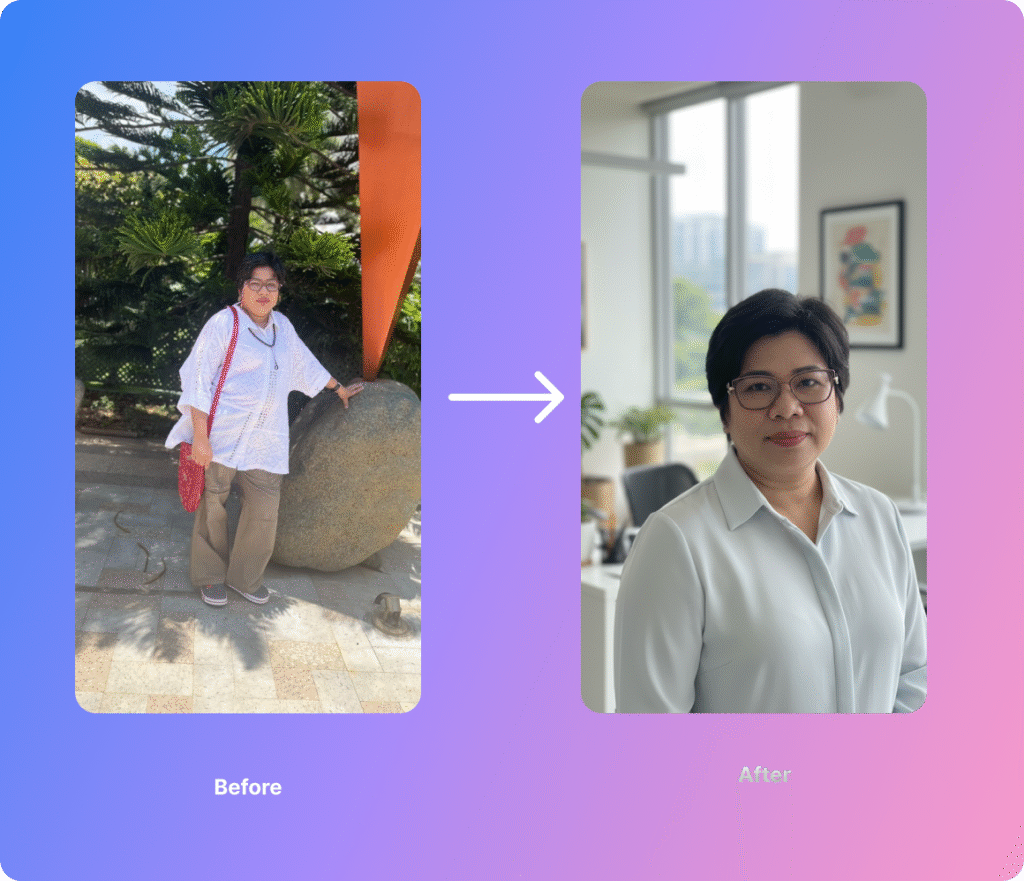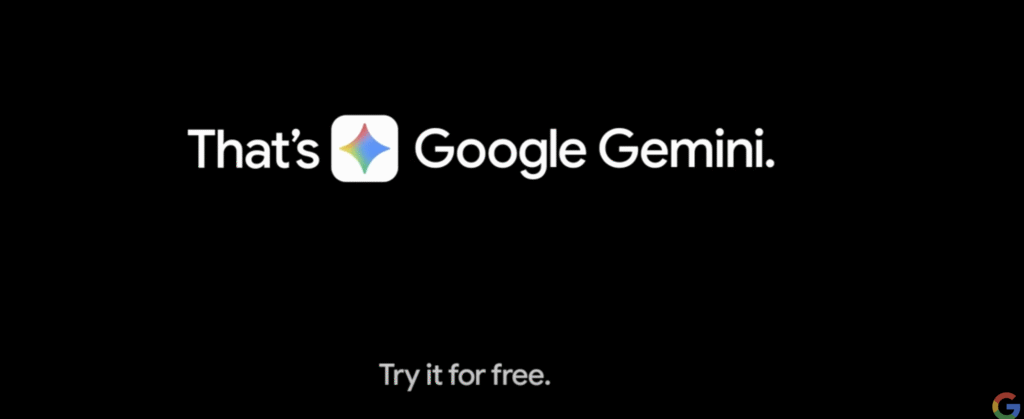
The Good: Strategic Brilliance in Simplicity

Democratised Creative Expression
Google’s decision to brand their image generation feature as “Nano Banana” rather than some sterile technical nomenclature was nothing short of genius. In an era where AI tools often intimidate users with complexity, Google created something approachable—a playground for profile pictures that anyone could master. The campaign transformed what could have been another enterprise AI announcement into a cultural phenomenon.developers.googleblog+1
The strategy capitalised on the universal human desire for self-expression whilst removing traditional barriers. Unlike professional photo editing software that demands expertise, Nano Banana offers sophisticated image manipulation through conversational prompts. This accessibility isn’t just user-friendly; it’s strategically astute—Google positioned itself as the AI company that gets regular people.google+1
Viral Engineering at Scale
The campaign’s four suggested prompts—graffiti mural, tarot card, neon sign, and ceramic mug—weren’t arbitrary creative choices. Each represents a distinct aesthetic category with built-in shareability quotient. The graffiti mural taps into urban culture and street art appreciation; the tarot card leverages spiritual aesthetics and mystique; the neon sign appeals to retro-futuristic sensibilities; whilst the ceramic mug adds whimsical, tactile charm.developers.googleblog
This strategic prompt curation drove over 200 million image edits within weeks of launch—a testament to Google’s understanding of viral mechanics. Each transformation becomes content marketing, with users essentially becoming brand ambassadors through their social sharing.hindustantimes
The Not-So-Good: Execution Blind Spots
Prompt Dependence and Creative Limitations
From a UX writing perspective, the campaign suffers from what we might call “prompt poverty”. Whilst the suggested prompts are clever, they create a creative bottleneck. Users who venture beyond Google’s curated suggestions often encounter inconsistent results. The AI’s performance degrades noticeably with complex or nuanced requests, leading to frustrated iterations.anangsha
The conversational interface, whilst seemingly intuitive, actually demands a specific type of descriptive literacy. Users must learn to “speak AI”—understanding concepts like aspect ratios, artistic styles, and composition terminology that aren’t immediately obvious to casual users. This creates an unintentional barrier to the very democratisation Google claims to champion.uxwritinghub
Brand Safety Concerns
Google’s approach to brand safety feels reactive rather than proactive. Whilst they’ve implemented SynthID watermarking and content guidelines, the campaign launched without robust mechanisms for preventing misuse. Users can generate potentially misleading profile pictures that blur the line between authentic and artificial representation—a particular concern in an era of increasing AI-generated misinformation.spinutech
The platform’s character consistency feature, whilst technically impressive, raises ethical questions about digital identity authenticity that Google hasn’t adequately addressed. This oversight could prove problematic as AI-generated profile pictures become mainstream.blog
Digital Marketing Perspective: Masterclass in Product Evangelism

User-Generated Content as Growth Engine
Google transformed a product launch into a self-perpetuating marketing ecosystem. Every Nano Banana creation becomes organic advertising, complete with implicit Google branding through the quality and style of outputs. The company essentially crowdsourced its entire marketing campaign.hindustantimes
The hashtag strategy—whilst not explicitly mentioned—naturally emerged through user behaviour. #NanoBanana became a discovery mechanism, creating a feedback loop where visibility drives adoption, which drives more visibility. This organic growth pattern is marketing gold.
Competitive Positioning Through Simplicity
Whilst competitors like Midjourney focus on artistic sophistication and DALL-E emphasises technical capabilities, Google positioned Gemini as the approachable AI. This isn’t about creating the most technically advanced outputs; it’s about creating the most accessible ones.uxplanet
The campaign subtly reinforces Google’s broader AI narrative: that artificial intelligence should augment human creativity rather than replace it. This positioning is crucial as AI anxiety grows amongst general consumers.ibm
UX Writer’s Assessment: Contextual Brilliance Meets Execution Gap

Upon examining Google’s actual interface design, a more nuanced picture emerges of their UX strategy. The promotional materials and viral marketing focused on specific prompts like “graffiti mural” and “tarot card,” but the platform’s onboarding reveals sophisticated user psychology at work.
The Genius of Contextual Suggestions
Google didn’t merely throw users into the deep end with generic prompts. They created personalised entry points based on common user desires and varying commitment levels:
- “Make my own custom mini figure” appeals to collectible culture whilst suggesting achievable creativity
- “Turn me into a superhero” taps into aspirational fantasy with clear visual expectations
- “Give me an 80s style makeover” leverages nostalgic aesthetic appeal with defined parameters
- “Create a professional headshot” addresses practical business needs with professional utility
This represents progressive disclosure done right—each suggestion carries different complexity levels and use cases, from playful experimentation to professional application. The interface acknowledges that users approach AI tools with varying confidence levels and objectives.
Microcopy Mastery
The headline “Want to try out a few things?” demonstrates exceptional UX writing principles:
- Non-committal language (“try out” vs “create”) reduces performance anxiety
- Exploratory framing (“few things”) suggests variety without overwhelming choice
- Conversational tone reduces AI intimidation through familiar phrasing
- Permission-based approach (“Want to”) grants user agency rather than demanding action
This copy directly addresses the cognitive barriers that prevent casual users from engaging with AI tools. It’s invitation rather than instruction.
Strategic Prompt Architecture
These aren’t random creative suggestions—they represent distinct value propositions across the user spectrum:
- Creative play (mini figure) – low stakes, high engagement
- Fantasy fulfilment (superhero) – emotional appeal, visual drama
- Aesthetic transformation (80s makeover) – cultural resonance, shareable results
- Professional utility (headshot) – practical application, career relevance
This spectrum covers entertainment through professional application, acknowledging that users seek AI tools for both frivolous and serious purposes.
Where Execution Still Falters
However, interface brilliance doesn’t eliminate deeper UX writing challenges. The platform still suffers from iteration guidance poverty. Once users complete initial suggestions, they’re left to navigate prompt engineering independently. There’s no progressive skill development or adaptive complexity introduction.
The semantic disconnect between “Nano Banana” branding and professional headshot creation remains jarring. Users seeking business applications must mentally reconcile playful terminology with serious outcomes—a cognitive load that sophisticated onboarding can’t entirely eliminate.
Missing Educational Scaffolding
Most critically, Google provides excellent entry points but limited learning progression. Users succeed with curated prompts but struggle when attempting custom variations. The interface lacks contextual hints about prompt modification, style consistency, or iterative refinement techniques that would transform casual users into confident creators.
The platform assumes users will intuitively understand concepts like aspect ratios, artistic style terminology, and composition principles—knowledge gaps that even excellent onboarding can’t bridge without explicit educational support.
This represents a strategic tension between accessibility and depth. Google optimised for immediate engagement over long-term user development, which drives impressive initial metrics but potentially limits sustained platform adoption beyond novelty usage.
AI Evangelist’s Assessment: Technical Innovation, Strategic Execution
Multimodal Integration Excellence
Gemini’s ability to understand and blend multiple input images represents genuine technological advancement. The platform can maintain character consistency across edits whilst incorporating new elements—a technical achievement that competitors struggle to match.cloud.google+1
The real-time processing speed sets new industry standards. Traditional AI image generation often involves lengthy wait times; Nano Banana delivers results in under 30 seconds. This responsiveness transforms user experience from patience-testing to genuinely interactive.hindustantimes
World Knowledge Integration
Unlike purely generative models, Gemini leverages its broader knowledge base to create contextually appropriate images. When users request “a tarot card,” the AI understands visual conventions, symbolism, and aesthetic expectations specific to tarot design. This semantic understanding elevates output quality significantly.developers.googleblog
End User Perspective: Delightful but Demanding

Accessibility Achievements
For users previously intimidated by professional photo editing software, Nano Banana represents genuine empowerment. The ability to transform mundane selfies into artistic interpretations democratises creative expression in meaningful ways.anangsha
The mobile-first design acknowledges how most users actually engage with image creation—on phones, spontaneously, for immediate social sharing. This platform understanding is crucial and often overlooked by desktop-centric AI tools.
The Bias Reality: When Enhancement Becomes Erasure

What initially appears as technical sophistication reveals troubling editorial decisions. The “professional headshot” transformation doesn’t merely improve lighting and composition—it systematically alters body proportions to align with conventional beauty standards.
Users seeking professional imagery may discover the AI has “corrected” their appearance based on training data biases. This isn’t enhancement; it’s digital assimilation towards narrow definitions of professional presentation. The tool that promises to democratise professional photography actually reinforces exclusionary workplace appearance norms.
The psychological impact extends beyond vanity. When users receive “improved” versions of themselves that conform to specific body types, it subtly suggests their authentic appearance requires correction for professional contexts. This creates a cognitive dissonance between self-acceptance and AI-mediated self-presentation.
Expectation Management Issues
However, the campaign created unrealistic expectations about AI capabilities. Social media showcases highlighted perfect results whilst obscuring the trial-and-error reality most users experience. This gap between marketing promise and practical experience generates frustration.
Users report difficulty achieving consistency across multiple images—a particular pain point for those wanting cohesive social media aesthetics. The AI’s interpretation of prompts can vary significantly, making it challenging to develop a recognisable personal visual brand.anangsha
How I Would Approach It Differently
Progressive Skill Development
Rather than launching with advanced features, I’d implement a tiered prompt system. Begin users with simple, guaranteed-success transformations before gradually introducing complexity. This builds confidence whilst teaching AI interaction skills organically.
Community-Driven Learning
Create a prompt library where users can share successful combinations with visual examples. This transforms the learning curve from frustrating to collaborative, whilst creating additional engagement touchpoints.
Professional Integration Pathway
Develop business-focused applications beyond profile pictures. Marketing teams could use similar technology for product photography, social media content, and creative brainstorming. This expands the addressable market whilst demonstrating serious commercial applications.
Ethical Framework Transparency
Implement clear visual indicators for AI-generated content across all platforms. Users deserve to understand when they’re viewing artificial versus authentic images, particularly in professional contexts.
The emphasis on bringing strategy to creativity mirrors this analysis of how Google transformed technical capability into viral cultural phenomenon through strategic positioning and accessible design.

The Nano Banana campaign succeeded not despite its limitations, but because Google understood something fundamental: in the attention economy, being perfectly accessible beats being perfectly advanced. Sometimes the most sophisticated strategy is appearing delightfully simple.
Sources:
- Google Developers Blog – Gemini 2.5 Flash Image introduction
- Typeface AI – AI image prompts for marketing
- Google Cloud – Vertex AI image generation documentation
- Google AI – Gemini API image generation
- Cascade Business News – AI image generation in marketing
- Firebase – Gemini image generation documentation
- Hindustan Times – Nano Banana viral prompts
- AI Research Institute – Generative AI in marketing
- Google Gemini Support – Image generation guide
- Google Gemini – Nano Banana official page
- M1 Project – AI-generated customer profiles
- Procreator Design – AI tools for UX workflow
- Anangsha – Nano Banana tutorial guide
- Various industry sources on AI marketing effectiveness
- https://developers.googleblog.com/en/introducing-gemini-2-5-flash-image/
- https://gemini.google/overview/image-generation/
- https://ai.google.dev/gemini-api/docs/image-generation
- https://www.anangsha.me/nano-banana-tutorial-how-to-use-googles-ai-image-editing-model-in-2025/
- https://www.hindustantimes.com/technology/google-gemini-nano-banana-7-prompts-to-generate-viral-instagram-photos-101758010616804.html
- https://uxwritinghub.com/ai-tools-for-ux/
- https://www.spinutech.com/digital-marketing/paid-media/how-googles-gemini-is-revolutionizing-campaign-building/
- https://blog.google/products/gemini/gemini-nano-banana-examples/
- https://uxplanet.org/6-ai-image-generator-tools-for-designers-2dd91477d808
- https://www.ibm.com/think/topics/ai-in-marketing
- https://www.typeface.ai/blog/ai-image-prompts-for-marketing-campaigns
- https://cloud.google.com/vertex-ai/generative-ai/docs/multimodal/image-generation
- https://ppl-ai-file-upload.s3.amazonaws.com/web/direct-files/collection_bfbfcb1e-e787-4210-bccb-b2f5c170628b/6179a609-225b-40d6-8494-32f2886ade6e/Metric-Post-launchLift.csv
- https://cascadebusnews.com/the-present-and-future-of-ai-image-generation-in-marketing/
- https://firebase.google.com/docs/ai-logic/generate-images-gemini
- https://research.aimultiple.com/generative-ai-in-marketing/
- https://support.google.com/gemini/answer/14286560?hl=en&co=GENIE.Platform%3DDesktop
- https://www.canva.com/ai-art-generator/global-trends/
- https://deepmind.google/models/gemini/image/
- https://zapier.com/blog/best-ai-image-generator/
- https://ai.google.dev/gemini-api/docs/imagen
- https://artsmart.ai/blog/ai-image-generator-market-statistics/
- https://www.ndtv.com/offbeat/top-10-google-gemini-ai-photo-editing-prompts-you-need-to-try-now-9298190
- https://www.youtube.com/watch?v=FwgJ25ScB88
- https://upcity.com/experts/ai-images-in-marketing/
- https://www.m1-project.com/blog/ai-generated-customer-profiles
- https://procreator.design/blog/ai-tools-to-speed-up-ux-design-workflow/
- https://www.inpixio.com
- https://pixlr.com
- https://digitaldefynd.com/IQ/ai-marketing-campaigns/
- https://imagen-ai.com
- https://www.invoca.com/blog/outstanding-examples-ai-marketing
- https://uxplanet.org/a-designers-take-on-ai-bb2b3b48a628
- https://yce.perfectcorp.com
- https://improvado.io/blog/ai-marketing-analytics
- https://uxpilot.ai
- https://www.adobe.com/in/products/photoshop/ai-photo-editor.html
- https://www.smartresultsmarketing.com/best-ai-profile-picture-generator
- https://uxmag.com/articles/i-tested-7-free-ai-image-generators-this-ones-my-pick
- https://www.canva.com/features/ai-photo-editing/
- https://www.sciencedirect.com/science/article/pii/S0167811624000843
- https://www.interaction-design.org/literature/article/ai-tools-for-ux-designers
- https://www.digitalsilk.com/digital-trends/brand-activation/
- https://dmxmarketing.com/google-gemini-reshaping-the-digital-marketing-landscape-in-2025/
- https://www.dentsu.com/id/en/insights/our-blog/what-is-brand-activation-and-how-does-it-work
- https://acadia.io/google-io-2024-key-takeaways-for-marketers
- https://clickup.com/blog/brand-activation-examples/
- https://professional.dce.harvard.edu/blog/ai-will-shape-the-future-of-marketing/
- https://geminiams.com/insights/2024-marketing-trends/
- https://pipeline.zoominfo.com/marketing/the-beginners-guide-to-brand-activation
- https://www.marketermilk.com/blog/ai-marketing-tools
- https://exposureninja.com/blog/what-is-google-gemini/
- https://buttercms.com/blog/online-brand-activations/
- https://www.quantilope.com/resources/best-ai-market-research-tools
- https://business.google.com/in/think/consumer-insights/digital-marketing-strategy-2024/
- https://socialwalls.com/blog/brand-activation/
- https://www.sciencedirect.com/science/article/pii/S2666603022000136
- https://www.designity.com/blog/what-is-google-gemini-what-marketers-should-know
- https://www.zappi.io/web/blog/what-is-brand-activation-and-how-to-make-yours-unforgettable/
